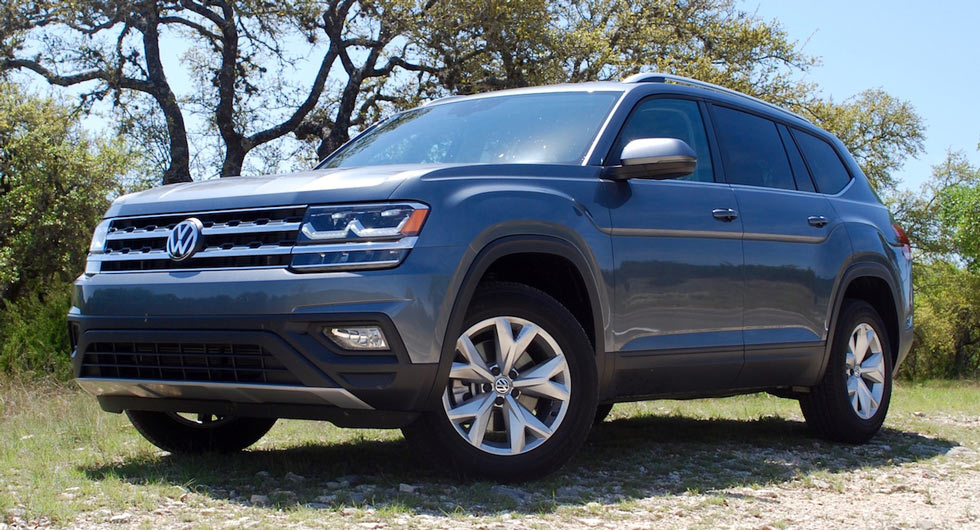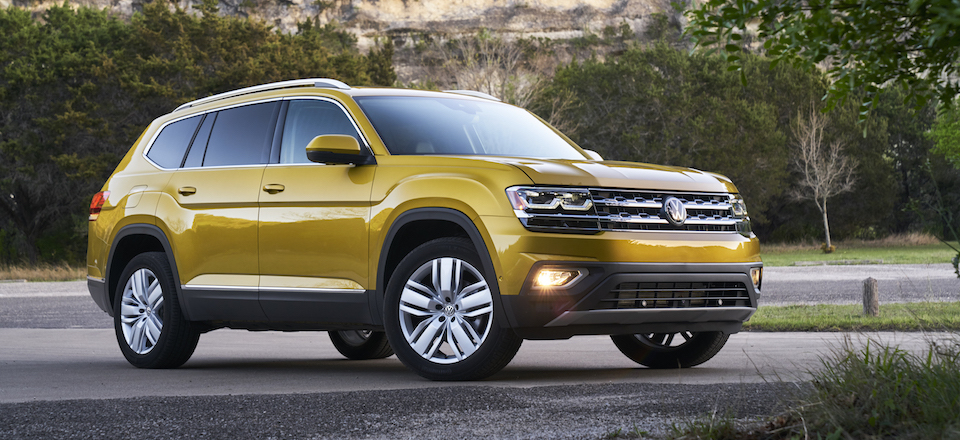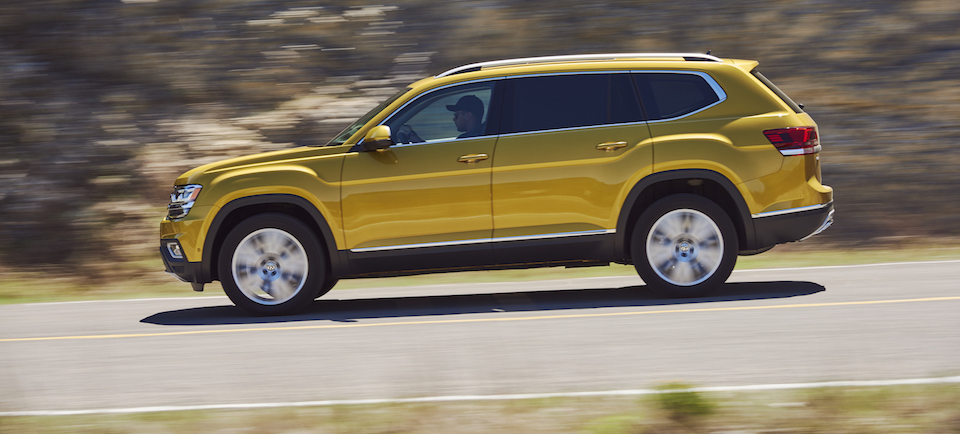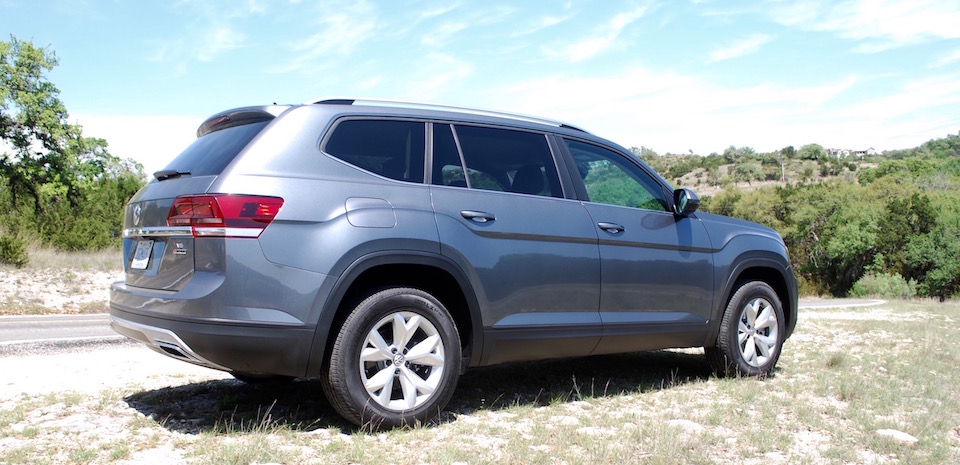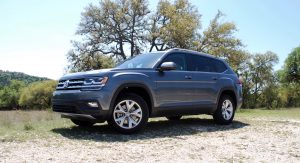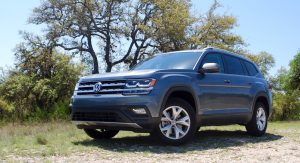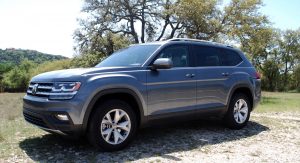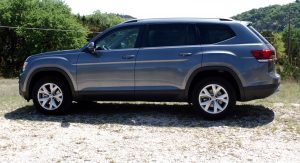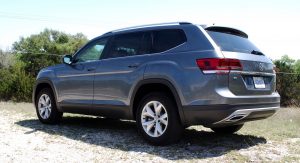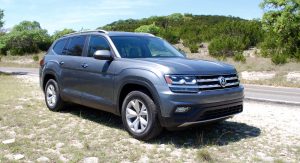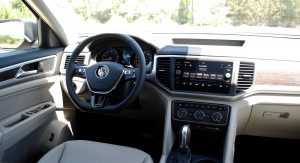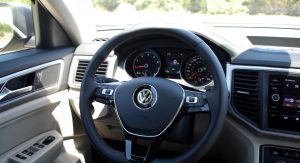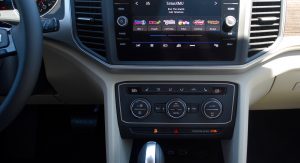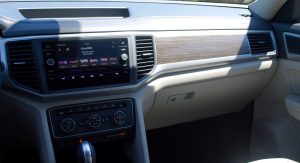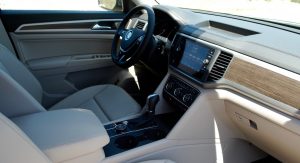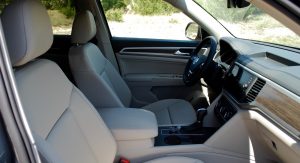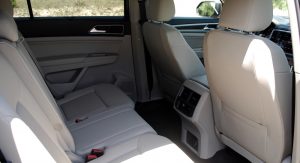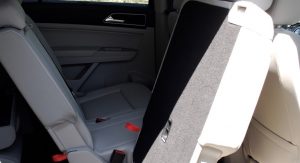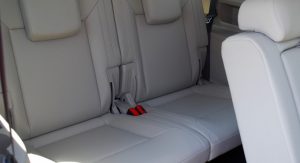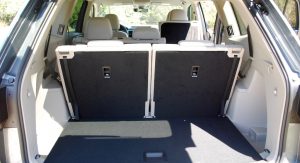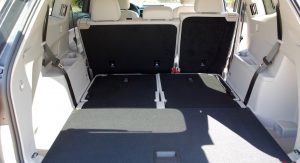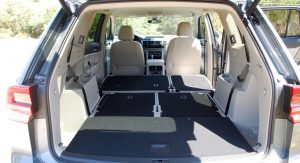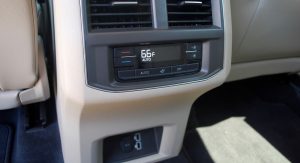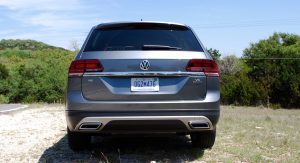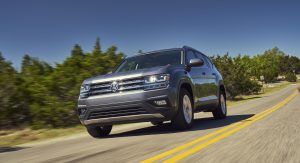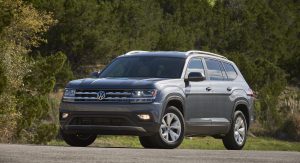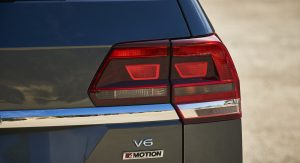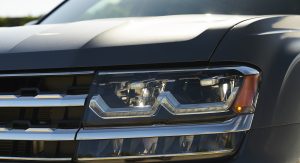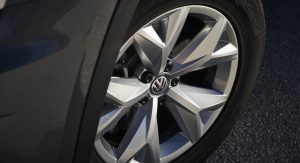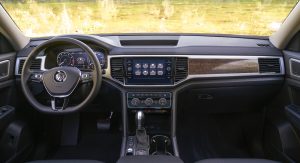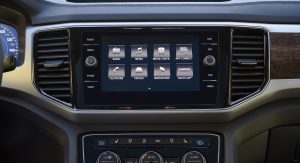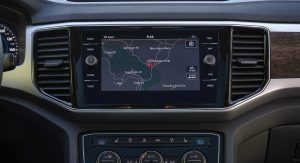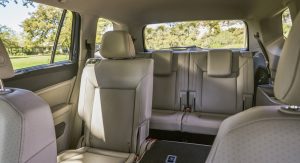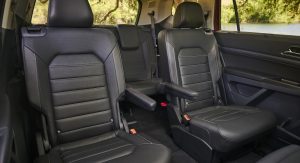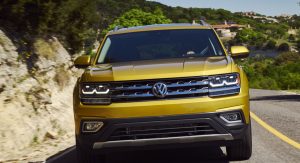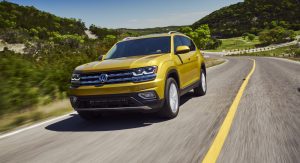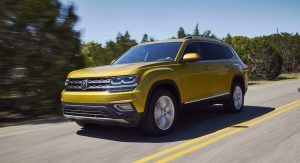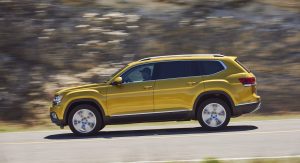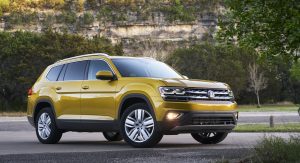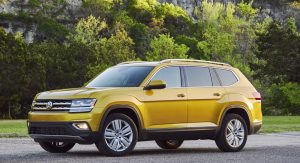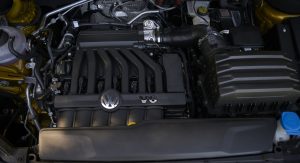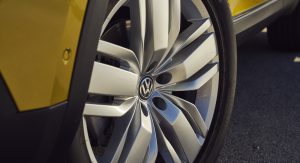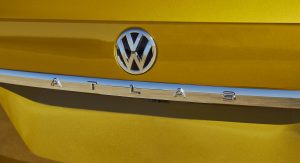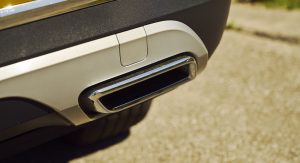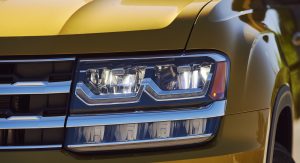The 2018 Volkswagen Atlas has arrived to a party where everyone is looking at what it’s doing.
After all, if you’re rolling in super late, you’d better have a good reason to back it up.
The Atlas is a product of VW’s failed attempt to regain a huge stake of the American market, an effort stalled not just because of corporate malfeasance, but also the drastic shift away from cars and minivans. Midsize SUVs have been the family transportation devices of the 2010s, decades after the last Transporter/Microbus/Vanagon left U.S. showrooms.
The Atlas doesn’t go after nostalgia, however, because it has very mainstream rivals in its sights. But in a crowded field, the Atlas has to not only be very good but also bring something new.
Face this fact: all these three-row SUVs look basically the same. Apart from some detailing, they’re pretty much just big boxes. The Mazda CX-9 may be the most seductive of them all, but it pays for that in other ways. The Atlas falls into the boxy category. In profile, it’s fairly anonymous, but it’s hardly offensive.
Detailing is more controversial. The enormous grille here does away with the simple three horizontal bars that have adorned most VWs this decade, in favor of a bumpy version of it that’s likely supposed to be tough, but comes off like a chromed topographical map, also echoed in the details of the standard LED headlights. And perhaps even more controversial are wheel arches that make the Atlas look as if it’s wearing particularly square shoulder pads.
The Atlas doesn’t hide it size, and with those puffy shoulders it looks like the big linebacker in full football gear. And that’s the most American sports reference I could think of. At 198 inches long, 70 inches wide and 78 inches tall, it’s a big boy even for this class. Which may be a plus for GMC Acadia owners upset the redesigned 2017 model shrunk in the wash.
I’ve warmed to the looks, anyway, because there’s logic inside.
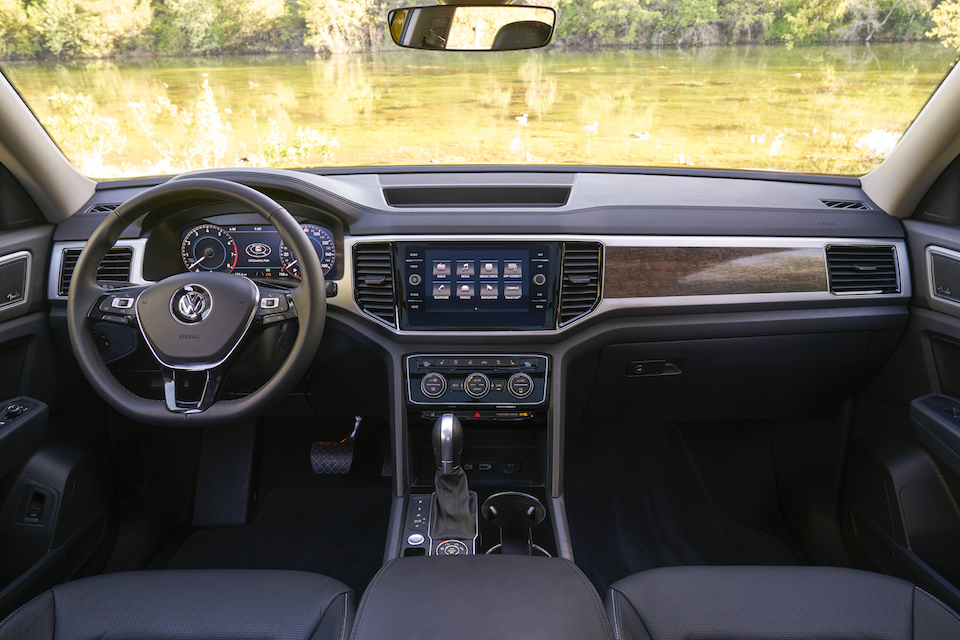
Wolfsburg looks, Chattanooga budget
Big box exterior means big box interior – and that’s a good thing if you’re buying something with seven seats. The Atlas is absolutely cavernous inside, seats up or down. Like its Americanized Jetta and Passat offerings, VW has decided to set its entry into a competitive field apart by supersizing the interior.
The effect is dramatic. The standard second-row bench seems conventional until you pull the lever under the outboard seats and find you can slide them back to get absurdly generous legroom. But you’ll have to move them a bit to give the two occupants in the third-row seats any legroom. Do that and lift one lever to reveal a huge space to actually get back in the third row (like the Nissan Pathfinder, it works even with a child seat strapped in). The Atlas has a third row seat even adults would find habitable, down to the air vents that are also mounted back there.
Leave all the seats up and there’s a decent amount of space for a couple of suitcases or bags. Fold the third row down and there’s a lot of space. But fold the second row, too, and there’s a fantastically long and tall space that could nearly shame a minivan. Acadia owners will recognize the space, although they would be envious that the seats in the Atlas fold completely flat.
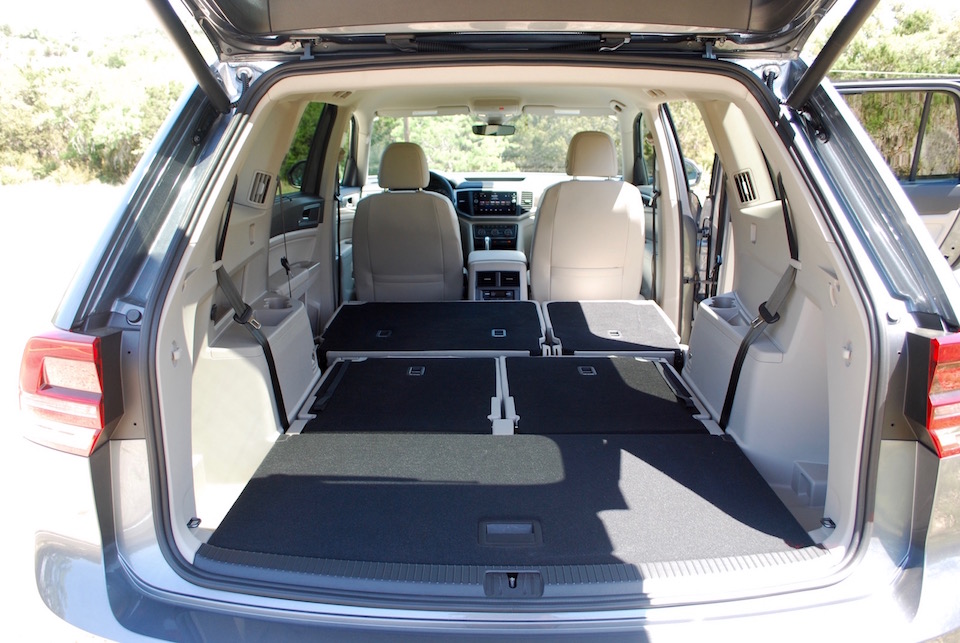
Every Atlas gets Apple CarPlay, Android Auto or MirrorLink, depending on your smartphone. This is good because navigation comes only on the most expensive SEL and SEL Premium models and is therefore bundled in with a lot of stuff you probably don’t want. Still, all but the most basic Atlas gets a bright new 8-inch touchscreen to control infotainment functions. And it’s backed by a faster processor than the smaller unit in other recent VWs, finally making it one of the more stable and easy to use systems out there.
Those who shell out for the SEL Premium also get the new Digital Cockpit, a 12.3-inch TFT screen in place of physical gauges and pretty much a simpler version of Audi’s Virtual Cockpit.
But VW apparently spent most of the Atlas’ interior budget because, despite its MQB origins shared with the Golf and more recent VW introductions, many pieces inside feel as cost-cut as the budget-conscious Jetta and Passat do. The door pockets and glovebox aren’t lined with fabric as they are on even a $20,000 Golf, either, so bottles and cans rattle when you’re driving along. Many surfaces other than the soft dash pad are hard when you smack your knee against them.
Even the solid old VW switchblade key has been replaced by a cheap plastic imitation, something a former Tiguan owner will be reminded of every time they open the power liftgate. At least keyless entry is standard on most models and can be operated from all the doors, not just the front two.
All but the most basic and most expensive models get seats covered in VW’s typical leatherette upholstery, which looks particularly fake when it’s gray. But the seats on the SE model I drove were more supportive and typically German firm than the soft and slightly overstuffed leather-covered ones in SEL Premium I also had seat time in.
None of these details are particularly bad when compared to the likes of the Ford Explorer and Honda Pilot, but they do nothing to help set the Atlas apart from the competition. Is the Atlas’ trump card in the way it drives?
Actually, yes, especially if you’re coming from a smaller VW product.
Derived from the same MQB platform that underpins the small Golf hatchbacks and wagons, the Atlas is more athletic than its dimensions would suggest. The launch near Boerne, Texas included numerous twisty back roads with ambitious 70 mph speed limits, yet the Atlas shrugs off its bulk reasonably well. It feels like an American Passat in most situations, with steering that has decent feel for the class and snappy responses from the pedals.
A 2.0-liter turbo four with 235 horsepower is standard on most Atlas models, mated only to front-wheel drive. VW doesn’t expect most buyers to go for it and some people in Chattanooga are probably wondering why they even bothered with it. It doesn’t sound like much punch, but consider it’s basically the heart of a Golf GTI and that engine’s torque could be sufficient for most in-town uses, especially if your Atlas will rarely be occupied by more than one or two people at a time. Think of it as the best post-TDI scenario for this rig.
But our time was limited to V6 4Motion all-wheel drive models, destined to be the most popular. The V6 is the long-serving 3.6-liter VR6 unit that comes all the way from Germany and has been serving in various Passat variants for more than 10 years now in its current form. It makes 276 horsepower here, but gets a new partner in the form of an 8-speed automatic.
The 4Motion system is the same Haldex unit found in the Golf Alltrack and its siblings, but with a new Land Rover-esque dial to select different modes depending on the conditions. Eight inches of ground clearance suggest the Atlas may be more useful than some of its peers in the rough stuff, but we didn’t get a chance to try any of that out.
Apart from a healthy dose of wind noise, there’s little to fault about the Atlas once you drive it. The high dash and cowl might take some getting used to, but it’s still an easy car to see out of, even to the rear when considering its length. The Explorer, Pilot, Highlander and CX-9 all feel bigger to drive.
Which is worth considering if you’re trying to figure out how to get a basketball team into a Jetta.
While the Atlas may not be a standout in any way, it more than holds its own against the swath of rivals in its wake. It’s the same story with pricing and equipment.
A base Atlas S with the 2.0-liter turbo will start at $31,425, including the $925 destination charge. Add $1,400 for the V6 and another $1,800 on top of that for all-wheel drive, meaning the least expensive Atlas you’re likely to see on lots will go for $34,825. That’s about $1,500 more than the least expensive Pilot AWD, but pretty much on top of where the Explorer V6 AWD starts off. Most buyers are expected to stick with the well-equipped SE with Technology AWD (pictured) at $39,815 or an SEL AWD for $43,615.
A lavish SEL Premium with the second-row captain’s chairs and black-painted wheels (both useless options, don’t bother) rings in at $50,275 – again, competitive with the most opulent iterations of its rivals.
Working for the Atlas is the interior space it offers and its top of the class driving dynamics. Against it is the questionable exterior styling and average interior quality. While it’s full of good ideas and is an altogether compelling package on this short drive, the Atlas is not exactly the revelation it needs to be to sway loyal Ford, Honda or Toyota buyers. Nor does it pull at any heartstrings to attract any VW loyalists not stung by Dieselgate.
The Atlas is beyond fashionably late. But those three-row SUV shoppers who bother to get acquainted with it should be glad they did.
Photos: Zac Estrada/Carscoops and VW



